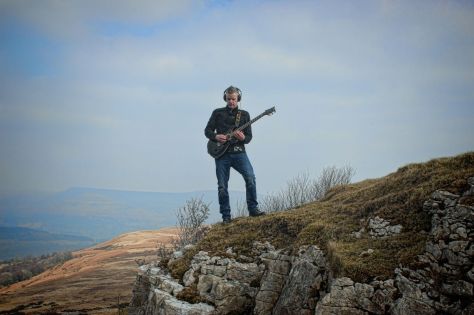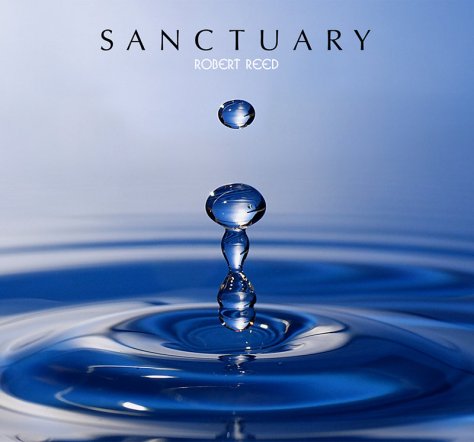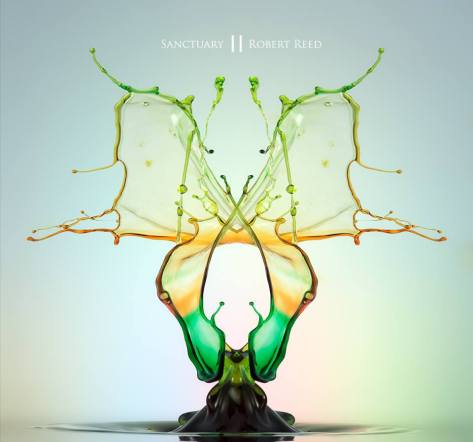
BY J. KENNEY
Although he may not be a household name in the United States, Robert Reed is a man of diverse musical talent. A multi-instrumentalist, composer and producer, Reed is best known throughout Europe as the founder of the Welch progressive rock band Magenta. Before that, he was creating equally compelling music with his band Cyan and side project Trippa. A self-proclaimed fan of 70s progressive rock music, Reed recently decided to salute his music hero, Mike Oldfield, by recording a solo album, called Sanctuary, in the style of Oldfield’s 1973 masterpiece Tubular Bells. Like Oldfield, Reed played every single instrument on Sanctuary and structured it exactly like Tubular Bells with two movement instrumental pieces. He was even aided by Tom Newman and Simon Heyworth who were members of the Tubular Bells production team.
Never one to shy away from a challenge, Reed immediately followed up his debut solo album with Sanctuary II. While he once again played almost every single instrument, this time he was joined by drummer Simon Phillips (Toto/Hiromi), who previously worked with Oldfield on four of his solo albums. The album was released this past June to critical acclaim.
Currently, Reed is rehearsing with a 10 piece band for a special Sanctuary Live performance on October 8th at the Big Room at Peter Gabriel’s Real World Studios. The performance will be recorded for a future CD and DVD release. Despite his busy schedule, Reed was gracious to grant us an interview where he offered in-depth and insightful answers to our questions.
LIMELIGHT MAGAZINE (LM): In order to put the following questions in context for our readers, could you briefly explain the impact legendary multi-instrumentalist Mike Oldfield has had on you as a musician, particularly in your formative years?
RORBERT REED (REED): Tubular Bells was the first album I had bought for me at the age of 7. I had heard a funky version of it on an album of horror film themes. I was captivated by it and played it to death. I then discovered the rest of M.O. (Mike Oldfield’s) catalogue. I just became inspired to learn to play all the various instruments, like my hero. I found in M.O. music a deep emotional content. The ability to move you with music without lyrics. There is something very special in M.O. guitar playing. It’s almost like a vocal connecting with you. I then became a massive fan of all his work and went to see him many times.
LM: Now moving ahead to 2014, you released your critically acclaimed solo album, Sanctuary, which pays homage to Oldfield in a big way. You structured the album exactly like Oldfield’s masterpiece, Tubular Bells, with two-movement instrumental pieces and played every single instrument. Why did you decide to tackle a solo project of this magnitude at this point in your music career?
REED: Alongside my career in music with my various bands Magenta/Komepndium, I have done lots of TV and film music. But I’ve always had a yearning to do a long form album like Tub(ular) Bells. Lots of people knew my influence which shows itself in my other projects and always asked when I would do the album. Then, at the beginning of 2013, on the first day of the New Year, I sat in the studio and asked myself what I really wanted to do, and started what became Sanctuary. The music just flowed for the following months. It was the most enjoyable album I have ever made, as it came from the heart. I knew I wanted it all to be played by hand, real instruments and using the long form template of classical music and Tub(ular) Bells. I also knew that I wanted vocals, but not lyrics. So I had to find singers who understood this. I was lucky to work with Synergy Vocals, a vocal group who work with Philip Glass and Steve Reich, so they knew exactly what I wanted.
LM: Sanctuary was co-produced by Tom Newman and mastered by Simon Heyworth who were both part of Oldfield’s 1973 Tubular Bells production team. How did you get them to assist you with this project?
REED: When I finished the first Sanctuary album, I really liked it, but wasn’t confident that it worked as a standalone album. It had been a labour of love, but wanted to check that it was NOT just a “clone” album that couldn’t be taken seriously.
So I thought I needed to put it to the test, musically, and who better than Tom Newman, who had made the original album. I know he is a very straight talking man and would say the truth. So I sent him a copy and asked his opinion. He replied and gave it his blessing and was really complimentary. There are loads of fan versions of M.O. material, and people who do YouTube demos in their bedrooms of M.O. music. Tom said that he is sent loads of these, but Sanctuary was different. It was actually NEW music, written in a similar style, but had managed to capture the spirit of what M.O. had done on those first four albums of his.
I also sent a copy to Simon Heyworth to ask a similar question of the music. He also replied and said the same, but also that he could close his eyes when listening to Sanctuary and he was back in the Manor Studios in 1973, and offered to master it. I was so pleased and had the confidence to go forward.

LM: What was it like working with them, especially since they come from a different era of recording, and how much input did they have on the finished album?
REED: Tom was such a help, he lives in Ireland so we had to do the collaboration via the internet. I had done a lot of the work already, so I sent him the individual tracks of the music, so he could extend, change the order and sound of each part. He had loads of suggestions. On the first album, he said that I was putting too much into the music, cramming too many themes. This is because these days I worry that people haven’t got the attention span, to listen to things and want everything changing and exciting all the time. Tom is the opposite and kept telling me to let the music breath. Also, I was going to add shorter tracks to the first album, to make the album longer, and to have “single” type songs to help promote it. Tom hatted this idea and just said that it spoilt the atmosphere created by the two long pieces… He was of course right.
On the new album Sanctuary II, Tom had even more of an input. I had finished the album and was about to send it be mastered. I thought I had better send Tom the finished mixes, for one last check, as I hadn’t spoken to him for a few months whilst doing the final mixes. I had a reply, where he said I had made the most perfect album in history BUT I had taken out all of the soul of the demos! I was devastated, but went back and checked some of the guide mixes Tom had done and he was right. Computers allow you to repair every mistake, everything in time, make everything sound perfect…but it’s not what we should be trying to achieve in music. It should be about soul and emotion and sometimes the little mistakes are what make it human. So I spent the next four weeks, mixing from a different perspective. To Tom, I owe a lot and am so grateful to have his input.

LM: After Sanctuary was released, you wasted no time and spent most of 2015 recording Sanctuary II. Was it your plan from the start to structure this follow-up album the same way as the first, which is also what Oldfield did on his second studio album Hergest Ridge?
REED: As I said, the first album was such a joy to make, also the reaction to it was so positive, that I really wanted to make a second album as soon as I could. There was no need to change the song format as it had worked so well on the first. I was also a lot more confident, so I could be more bold. I had also learnt lessons from Tom that I could bring to the new album, though he still would complain that I was squeezing too many ideas into the music.

LM: Unlike Sanctuary, you were aided by legendary drummer Simon Phillips on Sanctuary II who worked with Oldfield on four of his studio albums (Crisis, Discovery, Islands, and Heaven’s Open). Why did you decide to use a drummer this time around? Was it always your plan to work with Phillips? Were other drummers considered?
REED: With Sanctuary II, I wanted to add something new. I had avoided drums on the first album, as it really changes the atmosphere of the music, but thought it would be a challenge to use them on the second album, but tastefully. I had a wish list of drummers I thought who would understand the music. Simon was at the top, but I never dreamt that I would get him. I tracked him down and sent him an email, explaining what I had done and working with Tom and Simon and asked if he would listen to the demos. This he did, and he was really complimentary about how nobody was making this type of music anymore, so he agreed to play. He lives in America, so I sent him the backing tracks and he sent me his drums. The moment I played them against the music, I knew I had something special. Simon is also an amazing engineer and producer, so the drums sounded amazing and what he played was perfect. I never thought, back in 1984 watching Simon play drums at Wembley with Mike Oldfield, that years later he would be playing on my album. That was special.
LM: I’ve been listening to Sanctuary II non-stop since I ordered it online. While this album again pay tribute to Oldfield’s early works, the influence of some of his later releases shines through, particularly Platinum and Five Miles Out. Did this naturally progress this way or was this what you were aiming for when you started writing and recording the album?
REED: Yes, there are definitely more of the Platinum era. That’s because of the drums and how they make the music move. For me, there is a lot more influence of David Bedford the composer who M.O. worked with a lot in the 1970’s. David’s albums like The Odyssey was a huge influence. But again, there is a lot of me. The whole “influence v. plagiarism” debate is a weird one. When I released the first album, I split the M.O. fans down the middle. Half saying that they loved that I was bringing new music in a style they liked; the other half were very of protective of M.O. and hatted what I was doing. I remember M.O. saying how disappointed he was that after Tub(ular) Bells nobody else was inspired to make long form instrumental music. This is exactly what I am doing. Also, EVERYBODY has influences and brings them into their music. M.O. music is very stylized because of the instruments used, but so is classical music. Beethoven sounds like Bach, sounds like Mozart, because they all use the same instruments. It’s the melodies that set them apart. ELO (Electric Light Orchestra) sound like The Beatles. Steve Wilson [sounds like] King Crimson. Genesis took their sound from King Crimson, Marillion and Genesis….we all have influences. In the end it comes to this. IS THE MUSIC well written and performed and does it move you emotionally????? If it does then I have succeeded.
LM: Do you know if Oldfield has heard either of the Sanctuary albums?
REED: I’m not sure he has heard it. He must be aware of it, as it’s all over Facebook and YouTube. I’m not sure if M.O. is interested in anybody else’s music. I just hope he appreciates the spirit in which I made it, and the reason why I made these albums.
LM: Now that the album is out, you’ve been busy rehearsing for your Sanctuary Live shows on October 8th at the Big Room at Peter Gabriel’s Real World Studios. How are rehearsals going?
REED: I always wanted to play these albums live, but knew it would be a challenge, for obvious reasons. So, after the new album, I just put a date in the book, and forced myself to make it happen. We are in the middle of rehearsals, and it’s sounding fantastic, a little different than the record. It’s very had to play, as everybody has to play the right thing at all times for it to fit together like a jigsaw puzzle.
LM: You’re going to be performing with a 10-piece band. Since you performed almost every instrument yourself on both Sanctuary albums, how did you select these musicians to bring these albums to life?
REED: I had to find people who I could trust to be able to bring the right style of playing to each part. I also wanted people who I can get on with and feel comfortable around. We have two guitarists, two keyboard players, bass play, drummer, percussionist playing tub bells, times, marimba, etc., and three singers. It would have been very easy for me to play piano through it all, as that’s my main instrument, but I thought people would expect to see playing various instruments, so currently I’m playing a lot of guitar, some bass, and various percussion instruments…Its’ a real challenge, but fun.

LM: You’re recording the concerts for a future CD and DVD release. When do you expect them to be released?
REED: Not sure really, hopefully mid-2017. The concert is going to be very intimate, as Real World Studios is not really a venue. We can get 75 people in for each of the two shows, so I hope it’s going to be great for the audience to be surrounded by the band, visually and sonically. The plan is them to play more shows in more traditional venues, possibly with the same band or smaller, with different line ups. It’s weird I remember seeing M.O. perform Tub(ular) Bells II at Edinburgh He had a massive band and it was perfect, but it was a little too safe and boring. Then I saw him with a five-piece band and the music was completely different to the albums, but was so much more exciting. So you have to strike a balance when playing live.
LM: Speaking of the future, Oldfield concluded his two-movement trilogy of albums with Ommadawn in 1975. Are there plans for a third and final Sanctuary III album?
REED: I’d love to do a third album, but I need to find a sound in my head, and have a few ideas of what new to bring to it. At the moment, I’m completely consumed with the live shows. Though, I am planning a special E.P. for early 2017 that is the early stages of recording.
